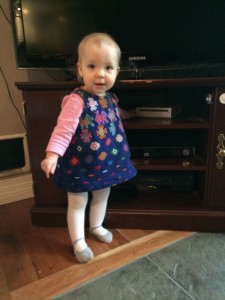
My little love has certainly come a long way from the helpless little being she once was.
After her first birthday, I really noticed some changes. Beyond the fact that she was now walking around, becoming more and more steady on her feet every day, she had suddenly developed a serious will of her own. She now knows what she wants, and will full out lose her spit when she can’t have whatever it is she’s set her sights on.
At first I was somewhat dismayed. What had we done to raise such an attitude?! Of course, after doing some reading to brush up on very young child development (am I the only one who still uses the library books for research?), I remembered the fault was not with us as parents, and was certainly not with our babe.
The problem lay within the fact that she is growing into her own little person. She is realizing that she can act upon the world to get what she wants – sometimes.

But not everything is safe or attainable, and she cannot fully understand why right now. She cannot converse with these large keepers of the scissors in a pleasant back-and-forth to explain what she wants, and come to know that the enticing pointy objects are dangerous for uncoordinated bodies (why I’m allowed to use them, then, is hard to answer).
The inability to communicate, and the lack of response to her desires leads to frustration and emotions that she doesn’t yet know how to deal with. It’s overwhelming for her. And what do you do when you’re a 1-year-old who doesn’t get what she wants, as soon as she wants it, feels unheard and rushes with strong new emotions?
It looks something like this.
And sounds something like… well… Let’s just say sometimes I worry the neighbours might call the police for fear we are boiling our child alive.
So, I’ve been using this little trick for helping my toddler learn patience for things that are to come, but not just yet.
Taking my ECE courses at CapU, this idea of “‘first’ and ‘then'” phrasing was just another tool tucked carefully into our childcaring belts of awesomeness. Now, as a parent who cannot send little Johnny home at the end of the day while I enjoy my care-free, childless life of wine and sheer laziness, I am appreciating all these tools in a whole new way.
When my toddler is insistent that she has or does something (A), but there is something else that needs to happen first (B), I calmly and slowly state “First (A), then (B)”. For instance, if little Z wants to nurse, but her diaper needs changing before we all meet with unfortunate poo-sibilities, I’ll attend to the fact that I understand what she wants (“You’re hungry. You want to nurse.”), then I say “First diaper on, then milk.”
By doing this, I am helping to relieve her frustration that she may feel for not being understood, and am giving her the language she needs in order to learn how to properly communicate her wants and needs. Using the “First, then” statement consistently, she is coming to understand the concept of waiting for what she wants. She calms down noticeably with this statement. I believe she understands that when I say this, whatever the “then” portion is, she knows it is coming and can relax and help me to finish the “first” priority so we can move on to what she really wants.
If you, too, are struggling with a willful and frustrated toddler, give this a try! I hope it’s helpful, and makes your day even a smidgen easier and more enjoyable. 🙂
What helpful tips do you have for parents and caregivers? Share them in the comments below, or post and connect with me on Facebook, Twitter, Instagram, Pinterest or YouTube.
If you liked this post, you might also like to read How To Make Life Easier With A Toddler, I Get By With A Little Help From My Toddler, and 4 Ways To Raise A Respectful Child.
One thought on “How Do You Teach a Child Patience?”
Pingback: 18 Tips To Make Life With A Toddler Easier